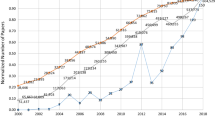Abstract
The handover of Hong Kong launched a new era for Hong Kong and Mainland China, featuring an increasingly closer relationship. The purpose of this study was to investigate the performance and dynamics of scientific collaboration between Hong Kong and Mainland China over the past 20 years since the handover. Bibliometric analysis of scientific output, research area distribution, document type and collaborative mainland province were conducted based on publication data from the science citation index expanded database. The results showed that the number of HK-Mainland collaborative publications grew rapidly, contributing to the scientific output of Hong Kong, with the percentage share increasing to more than half in 2016. Research area analysis suggested the occurrence of gradually deepening and widespread communication between Hong Kong and Mainland China. Of fifty research areas in Hong Kong, more than half of scientific publications were completed via collaboration with the mainland in 2017. The mainland provinces that collaborated with Hong Kong showed a widening geographic scope and a simultaneous increase in collaborative activity. A distribution of Guangdong Province and Beijing as the two most active hotspots with a dozen active spots across the mainland was gradually formed. The collaborative activity of Guangdong Province has exceeded that of Beijing since 2011, while that of Guangzhou and Shenzhen increased linearly and exponentially respectively, and contributed at least 70% to Guangdong Province every year. The relationship between Hong Kong and Mainland China in science and technology has become closer than ever before.





Similar content being viewed by others
References
Brown, T. L., Gong, T., Jing, Y. J., et al. (2012). Collaborative governance in Mainland China and Hong Kong: Introductory essay. International Public Management Journal, 15(4), 393–404.
Finardi, U., & Buratti, A. (2016). Scientific collaboration framework of BRICS countries: An analysis of international coauthorship. Scientometrics, 109(1), 433–446.
Guns, R., & Wang, L. L. (2017). Detecting the emergence of new scientific collaboration links in Africa: A comparison of expected and realized collaboration intensities. Journal of Informetrics, 11(3), 892–903.
He, T. W. (2009). International scientific collaboration of China with the G7 countries. Scientometrics, 80(3), 571–582.
Horta, H. (2017). Is the research system in Hong Kong losing its competitiveness? In G. A. Postiglione & J. Jung (Eds.), The changing academic profession in Hong Kong (pp. 77–95). Dordrecht: Springer.
Horta, H. (2018). The declining scientific wealth of Hong Kong and Singapore. Scientometrics. https://doi.org/10.1007/s11192-018-2845-0.
Kim, K. W. (2006). Measuring international research collaboration of peripheral countries: Taking the context into consideration. Scientometrics, 66(2), 231–240.
Li, J. (2016). The global ranking regime and the reconfiguration of higher education: Comparative studies on research assessment exercises in China, Hong Kong, and Japan. Higher Education Policy, 29(4), 473–493.
Lo, W. Y. W. (2018). Hybridization and higher education governance in Hong Kong. Journal of Asian Public Policy, 1(2), 14–27.
Lo, W. Y. W., & Ng, F. S. K. (2013). A critical reflection on internationalization of higher education in Hong Kong: The search for a cosmopolitan alternative. Asia Pacific Journal of Educational Development, 2(1), 37–46.
Lo, W. Y. W., & Tang, H. H. H. (2017). Dancing with global trends: Higher education policy and university governance in Hong Kong, 1997–2012. Journal of Educational Administration and History, 49(1), 53–71.
Luukkonen, T., Persson, O., & Sivertsen, G. (1992). Understanding patterns of internatonal scientific collaboration. Science, Technology and Human Values, 17(1), 101.
Mao, G. Z., Liu, X., Du, H. B., et al. (2015). Way forward for alternative energy research: A bibliometric analysis during 1994–2013. Renewable and Sustainable Energy Reviews, 48, 276–286.
Mok, K. H. (2012). The quest for innovation and entrepreneurship: The changing role of university in East Asia. Globalisation, Societies and Education, 10(3), 317–335.
Niu, B. B., Hugo, A., Wang, Z., et al. (2014). Twenty years of global groundwater research: A science citation index expanded-based bibliometric survey (1993–2012). Journal of Hydrology, 519, 966–975.
Postiglione, G. A. (2013). Anchoring globalization in Hong Kong’s research universities: Network agents, institutional arrangements, and brain circulation. Studies in Higher Education, 38(3), 345–366.
Sharif, N., & Tang, H. H. H. (2014). New trends in innovation strategy at Chinese universities in Hong Kong and Shenzhen. International Journal of Technology Management, 65(1–4), 300–318.
van Raan, A. F. J. (2005). For your citations only? Hot topics in bibliometric analysis. Measurement, 3(1), 50–62.
Wagner, C. S., & Leydesdorff, L. (2005). Network structure, self-organization, and the growth of international collaboration in science. Research Policy, 34(10), 1608–1618.
Wang, X. W., Xu, S. M., Liu, D., et al. (2012). The role of Chinese-American scientists in China-US scientific collaboration: A study in nanotechnology. Scientometrics, 91(3), 737–749.
Zhang, L. (2014). Growing trend of China’s contribution to tissue engineering. Scientometrics, 98, 1423–1433.
Zhu, C. Y. (2017). Summary of achievements and the reason of Hong Kong since the handover. Journal of Ideological and Theoretical Education, 7, 88–93.
Acknowledgements
This work was supported by the Scientific and Technological Innovation Project of the Ministry of Science and Technology of China (Grant No. ZLY2015147).
Author information
Authors and Affiliations
Corresponding author
Rights and permissions
About this article
Cite this article
Ma, Q., Li, W. Growing scientific collaboration between Hong Kong and Mainland China since the handover: a 20-year bibliometric analysis. Scientometrics 117, 1479–1491 (2018). https://doi.org/10.1007/s11192-018-2916-2
Received:
Published:
Issue Date:
DOI: https://doi.org/10.1007/s11192-018-2916-2




